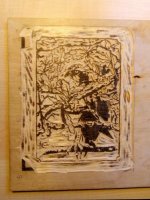Well this by David Bull has been completely invaluable resource
http://woodblock.com/encyclopedia/index.html
I'm having to stray from the 'pure' path a fair bit, not only being so far away from suppliers where you can go in and see things but also it would get very expensive to experiment with good cherry blocks. There must be some wood that comes close - high quality lime is very good but, again, you have to buy several meters of it to see what quality is actually on offer. The easiest, cheapest and most consistent material is printers ply which is what the above is on. It would be lovely to get hold of some proper cherry just to see how it works as a comparison (I have a feeling it would be a lot nicer to work with.)
Another thing is the traditional way of transferring the art to the block. That is sooo hard! A very thin paper is used on which the artist paints the black lines of the picture. That is then pasted face down to the block and the paper rubbed away leaving only the ink - sounds easy enough but as soon as the paper hits the paste it expands, That wouldn't be too bad if it was to stay 'black and white' but from the first block several prints are made - one for each colour block and then pasted and cut on a new block. Cutting the 'keyline destroys the original drawing so if anything goes wrong then the block cutter would be going back to the producer to ask the artist to draw it again - and that would be the last time they got the gig! The potential for mis-registration is enormous and, to be honest, it would be years of failure to get anywhere near a good result (even if I didn't sack myself!)
So I've cheated - well not so much cheated but used what they didn't have which is a scanner to capture the original and an inkjet printer to print onto wax paper and transfer the wet image to the block that way. Its still getting original brushwork on paper reversed onto the block but with the confidence that the subsequent blocks will be perfectly registered and any blocks that are messed up when cutting (all too easy) can be printed again.
So far so good...
The bit I'm really looking forward to is that when the blocks are ready then the colours can be experimented with. They can be changed and blended on the blocks so, even when the best effect is settled, no two prints will be quite exactly the same. Although Mrs G in the oak tree is ideal for testing the paper with a single colour (black), adding some greens with a simple second block should be nice.


